You also want an ePaper? Increase the reach of your titles
YUMPU automatically turns print PDFs into web optimized ePapers that Google loves.
KORPUS <strong>21</strong>, VOL. 2, NÚM. 4, 2022, 117-132<br />
and that of the white-collar office jobs they<br />
occupied. Those who spoke out provided<br />
a feminist critique of patriarchy in and beyond<br />
the office, exposing the way work and<br />
socio-cultural spheres mutually reinforced<br />
patriarchy.<br />
Women’s work force participation<br />
Sociologists and legal scholars point to the<br />
fundamental role that social and workplace<br />
inequality play in the exercise of power at<br />
work, one manifestation of which is sexual<br />
harassment (Veláquez Narváez and Díaz<br />
Cabrera, 2020: 428). Unequal workforce<br />
participation, hiring, promotion, and wages,<br />
for example, lay the basis for devaluing women,<br />
the gendered exercise of power, and<br />
sexual harassment, which they refer to in<br />
broad terms as workplace violence (violencia<br />
laboral). In Mexico, as in many countries,<br />
as women entered into the paid labor force,<br />
they did so along lines of gendered segmentation<br />
of the work force, occupational segregation,<br />
and gendered wage differentials.<br />
Discrimination reinforced barriers to women’s<br />
advancement (Rendón, 2003; Porter,<br />
2008, 2020). Just as contemporary scholars<br />
associate workplace inequality with sexual<br />
harassment, so too did Mexican women in<br />
the 1920s. What were the working conditions<br />
they faced at that time?<br />
In the late nineteenth and early twentieth<br />
centuries, middle-c<strong>las</strong>s gender norms associated<br />
women with the private sphere in<br />
such as way that when they took work outside<br />
of the home, they were understood to<br />
have entered a masculine space where they<br />
were sexually vulnerable. When Indian and<br />
Mestiza women worked in the public sphere,<br />
marketing goods or carrying laundry to and<br />
from clients, despite such c<strong>las</strong>s-based norms,<br />
middle- and upper-c<strong>las</strong>s observers associated<br />
them with licentious sexuality (Arrom,<br />
1992). In speaking about women’s entrance<br />
into factories and workshops, politicians,<br />
employers, and journalists fretted over the<br />
impact of “mixing the sexes”. Newspapers<br />
described women facing a workplace as<br />
filled with “sarcasm”, a reference to crude<br />
and aggressive language that could include<br />
sexual harassment (Porter, 2008: 106).<br />
When in the 1880s women first worked in<br />
federal offices, observers expressed concern<br />
over the morality of that workspace as<br />
well. The writer, diplomat, and government<br />
employee, Federico Gamboa, for example,<br />
was very concerned about the changes in<br />
the moral fabric of Mexican society, especially<br />
as it related to women. Reflecting on<br />
the hire of the first women to work in government<br />
offices, he wrote:<br />
At first I thought it fine, which indeed it is; but,<br />
just because it is fine doesn’t mean that the<br />
inevitable dangers caused by proximity between<br />
the two sexes don’t exist. As long as a<br />
man is near women there will always be desires,<br />
temptations, and risks (Gamboa, 2016:<br />
230-234).<br />
Some intellectuals understood work as<br />
a corrupting force on women’s morality, as<br />
did Dr. Luis Lara y Pardo, who ranked the<br />
occupations most likely to corrupt women<br />
and lead them to practice prostitution. His<br />
rankings reflected his race and c<strong>las</strong>s biases<br />
and did not acknowledge the ways certain<br />
occupations were more likely than others<br />
to leave women economically and sexually<br />
vulnerable (Lara y Pardo, 1908: 35).<br />
Once the violent phase of the Mexican<br />
Revolution ended, Presidents Álvaro Obregón<br />
(1920-1924) and Plutarco Elías Calles<br />
(1924-1928) committed themselves to the<br />
institutionalization of the revolution. Specifically,<br />
institutionalization meant that politicians<br />
and statesmen began to work on the<br />
approval of laws and the opening of offices<br />
to carry out the reforms promised by revolutionary<br />
leaders and in the Constitution of<br />
1917. Their objective was to create a strong<br />
state to support economic growth, mediate<br />
c<strong>las</strong>s conflict, and create political consensus.<br />
These initiatives required an enormous<br />
amount of paperwork. According to Mercedes<br />
Blanco, between 1920 and 1924, the<br />
Federal government grew at an annual rate<br />
of 11.5% (Blanco, 1995: 125). The demand for<br />
employees was met, to a large degree, by<br />
119


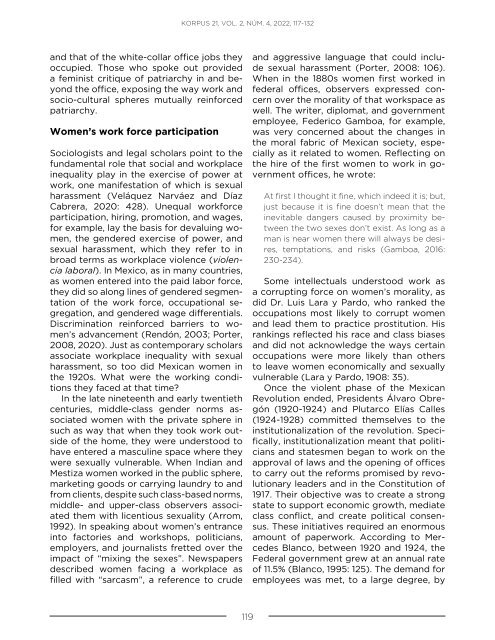
![bicentenario_1[V2]](https://img.yumpu.com/68677971/1/167x260/bicentenario-1v2.jpg?quality=85)

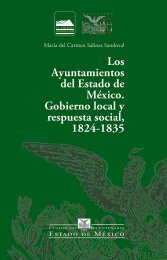

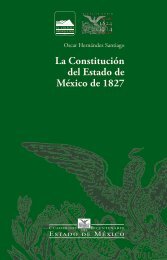
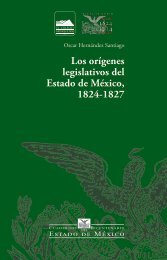
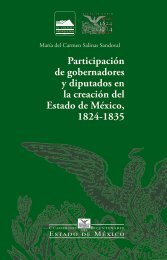
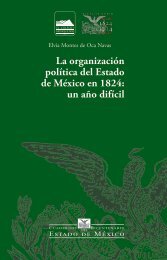
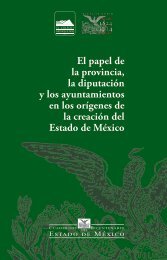

![El_primer_federalismoEM[final]_compressed (2)](https://img.yumpu.com/68483279/1/178x260/el-primer-federalismoemfinal-compressed-2.jpg?quality=85)



